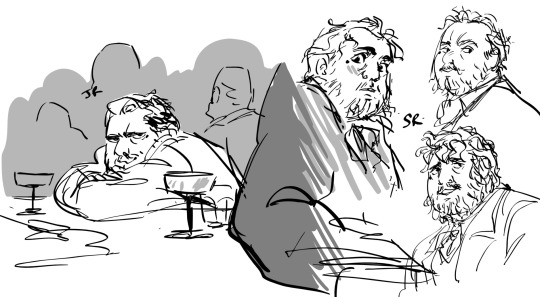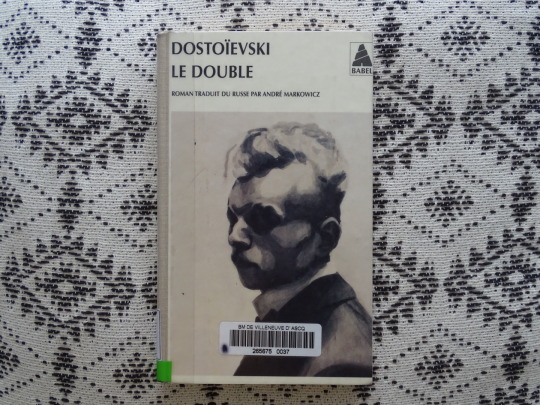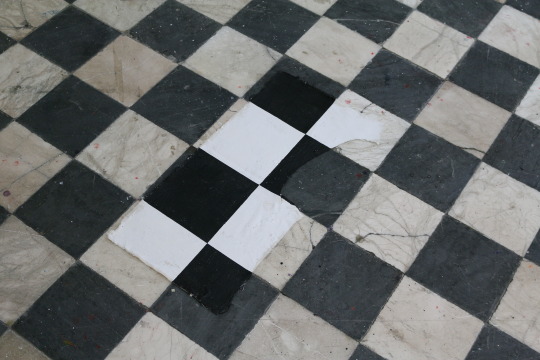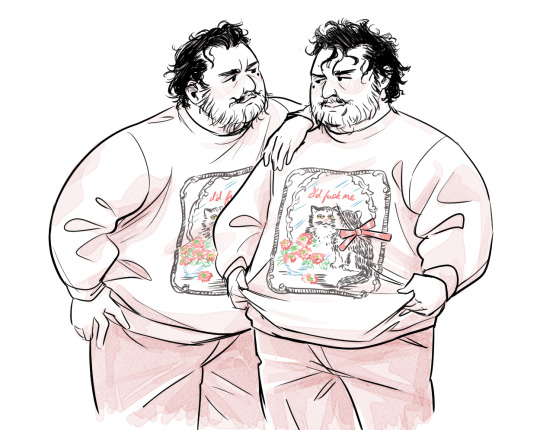#Goliadkin
Text


i think goliadkin and his double should just get it over and done with and fuck


#golyadkin#goliadkin#the double#fyodor dostoevsky#dostoevksy#i hope there are some out there who agree#is it gay for a guy to want to blow up his life by a better version of himself that he can't admit to himself#and at one point he reflects on improper thoughts while staring him down#and there is kissin#and he calls him his horror and shame personified???#just seems slutty
8 notes
·
View notes
Text
I am glad that I am not the only one that returns from Goliadkin’s dialogue in disbelief and confusion, and that the other characters, too, think he is deeply mad. It is as if Dostoevsky is telling me not to worry; that it is intentional.
2 notes
·
View notes
Text
Review #35
The Double
Penulis : Fyodor Dostoevsky
Goodreads Rating : 3.69/5
Buku ketiga dari Fyodor Dostoevsky yang aku baca, setelah Notes from the Underground, dan The Gambler. Sejujurnya aku telah berniat menulis review sejak buku pertamanya yang aku baca, namun rasanya sungguh berat. Berat dari isi bukunya, juga dari keinginanku untuk menggerakkan jari-jariku. Mengingat kembali bahwa Dostoevsky adalah salah satu penulis sastra klasik termahsyur di dunia sepanjang masa, rasanya di buku ketiga ini aku harus memaksa jari-jariku untuk sedikit menuliskan pengalaman membaca karya penulis asal Rusia ini.
Ditulis pada tahun 1846. Menceritakan tentang Yakov Petrovich Goliadkin, seorang anggota dewan perwakilan (titular councillor?), yang digambarkan memiliki kepribadian yang sinis dan sentimental. Pada suatu hari, ia bertemu dengan seorang yang memiliki penampilan dan nama yang sama persis dengannya, namun dengan sifat bertolak belakang. Kehadiran si kembaran ini kemudian menimbulkan pergolakan psikologis dalam dirinya, seiring satu sama lain berusaha saling menjatuhkan.
Sejujurnya menurutku konflik antar kedua tokoh dan dengan tokoh lainnya dalam cerita ini tidak terlalu ‘wah’, namun ada konflik yang jauh lebih menarik yang disajikan Dostoevsky: konflik antara tokoh dengan pikirannya sendiri. Buku ini dipenuhi pergolakan batin dan pikiran Goliadkin. Mulai dari ia memikirkan suatu rencana, kemudian menimbang kemungkinan-kemungkinan yang dapat terjadi setelahnya, lantas terjadi kebimbangan atas rencananya sendiri, akhirnya dengan ‘terpaksa’ mengambil suatu keputusan apa yang ia harus lakukan, dan diakhiri (sebagian besar) dengan penyesalan atas keputusan yang diambilnya tersebut, ya semacam itu.
Hal semacam di atas semua dinarasikan Dostoevsky dalam suatu kalimat panjang tanpa jeda paragraf. Di satu sisi, hal ini sungguh menarik, bagaimana kompleksitas pikiran manusia dituliskan dengan runut, tetapi di sisi lainnya ini dapat menjadi hal yang membosankan. Bayangkan hampir tiap pikiran tokoh dituliskan dengan sebegitu detailnya, sampai sering kali aku merasa bahwa ada yang salah dengan tokoh kita ini. Tetapi tidak juga, dipikir kembali memang begitulah isi pikiran manusia: “semrawut”. Tipikal penulisan ini sejujurnya tidak membuatku terkejut lagi, mengingat di dua buku Dosktevsky sebelumnya yang kubaca menggunakan gaya penulisan yang kurang lebih sama, ya memang seperti itulah ciri khasnya.
Kompeksitas pikiran Goliadkin juga membuatku berpikir: jangan jangan semua ini hanya ada di pikiran Goliadkin saja, jangan jangan ia hanya mengada-ada, berhalusinasi. Semakin aku membaca, rasanya semakin aku menjadi pengidap Schizophrenia. Tapi rasanya semua itu tidak penting lagi disimpulkan. Seolah memang begitulah dunia tempat kita hidup: ganda. Kebohongan, kebenaran, ilusi, fakta, sudah menyatu dan tidak jelas batasnya, semua terasa nyata.
Kehadiran kembaran ini juga boleh jadi adalah alegori, menggambarkan bagaimana seseorang (dalam hal ini Goliadkin) tidak puas dengan dirinya sendiri dan kesulitannya beradaptasi di masyarakat. Akhirnya ia menciptakan kepribadian lain yang bertolak belakang, yang banyak disukai banyak orang. Dalam pikirannya ia merasa marah karena sebagaimana pun ia mencoba, ia tetap tak bisa merubah dirinya. Semakin berandai bagaimana jika ia adalah dirinya yang lain, semakin ia membenci dirinya dan kehidupannya.
Hal yang mengangguku selama membaca buku ini adalah sebagaimana yang telah kutuliskan sebelumnya, ceritanya padat sehalaman dengan sedikit (atau bahkan tidak ada) jeda paragraf dan baris, dialog antartokoh juga minim sekali, semua ini membuatku terkadang pusing kehilangan fokus terhadap bagian yang dibaca. Membaca labirin isi pikiran yang dituliskan dengan detail kadang membuatku juga ikut berpikir, kemudian menjadi tersesat, memikirkan kembali sebenarnya apa yang sedang kubaca. Kepala ikut terasa berat.
Kompleksitas pikiran tokoh utama dalam buku seperti ini memang menjadi ciri khas tulisan Dostoevsky. Bukan buku yang mudah dibaca, boleh jadi belum tentu juga dapat langsung memahami apa yang sedang dibaca pada saat itu atau pun seselesainya. Namun iya, buku dengan cerita dan penulisan semacam ini adalah tipikal buku yang tepat sekali dijadikan bahan untuk diskusi. Bahkan, dirimu bisa takjub dengan banyaknya pembahasan kritis dari pembaca pembaca lainnya yang sama sekali tak terpikirkan olehmu. Ya, itulah yang terjadi padaku.
Depok, 27 Februari 2023, 7.11 PM
7 notes
·
View notes
Text
i just finished reading the first chapter of the double by dostoevsky: the social anxiety going on is so strong it’s stressing me out. goliadkin thinks like me. in a way it’s fun because wow representation of anxiety but i wasn’t expecting that when i started reading it and it’s a bit overwhelming. some people might think it’s funny though and i can see that but for me it’s just like reading my thoughts all over again
5 notes
·
View notes
Text

Un versito del otro Goliadkin
El doble
Fiodor Dostoievski
1 note
·
View note
Text
Le double - Fedor Dostoïevski
“Il voulait se cacher loin de lui-même, n’importe où, il voulait s’enfuir loin, n’importe où, de lui-même.”
Cela faisait un moment que j’avais envie de replonger dans du Dostoïevski, après avoir lu Le Joueur et Crime et Châtiment à l’automne dernier. Ma dernière excursion à la médiathèque m’a permis de combler ce souhait, puisque j’y ai trouvé Le double, entre autres livres de mon auteur russe préféré.

Qu’est-ce que ça raconte ?
Iakov Pétrovitch Goliadkine est un fonctionnaire de l’Etat russe. Il travaille dur, et bien, mais ce qui compte avant tout pour lui, c’est de se montrer tel qu’il est, lui qui méprise ceux qui se cachent derrière un masque. Pourtant, l’arrivée en ville d’un homme qui lui ressemble comme deux gouttes d’eau et qui, en plus, est un de ses homonymes bouscule tout son univers. Le double, d’abord mielleux et agréable avec Goliadkine, finit par faire de son quotidien une perpétuelle humiliation et se substitue à lui : c’est le début d’une spirale paranoïaque et fiévreuse pour Goliadkine, qui découvre qu’un complot bien sombre a été mis en place contre lui...
Une fois encore, je succombe à la plume de Dostoïevski, et au superbe travail de traduction d’André Markowicz. Le récit est surprenant, se joue de Goliadkine et du lecteur. A la fin, Iakov Pétrovitch, mis en exil, se dit qu’il avait toujours ce qui se tramait, mais quoi finalement ? Goliadkine est-il malade ? Le double existe-t-il pour tous les personnages ou seulement pour Goliadkine ? Son docteur même semble avoir peur de son état à la fin du poème pétersbourgeois. Le lecteur reste dans le flou et peut inventer ses propres explications. Par ailleurs, ce que j’ai trouvé très intéressant dans les interactions entre Goliadkine et son double, c’est la façon dont Goliadkine répétait sans cesse que la majorité des gens portait un masque en permanence, ce qui n’était apparemment pas son cas, alors même que l’usurpateur remplissait tous les critères en sa qualité de flatteur. Il se montre très plaisant avec tout le monde et tous tombent dans le panneau, y compris Goliadkine qui, le premier soir, pensait avoir trouvé en lui un frère, la seule personne avec qui il pourrait parler librement. Le travail de Dostoïevski sur un sentiment fiévreux enferme progressivement le lecteur dans le piège qui se prépare pour Goliadkine, j’ai trouvé le processus très intéressant, même si dans l’ensemble, les dialogues étaient tout de même très répétitifs.
Vous voulez l’acheter ? Je recommande l’édition Babel, pour sa traduction de qualité malgré quelques coquilles à l’impression. Le travail effectué par André Markowicz est remarquable et est disponible à la Fnac pour 8,70€.
#french review#book review#fedor dostoievski#Fiodor Dostoievski#book worm#book shelf#bookworm#book addict#book lover#literature#russian literature
0 notes
Photo







Sergio Verastegui
Pellejos Sueltos
Curadoría de Francesco Giaveri y Tiago de Abreu Pinto
Inauguración: 17/09/2016
Yakov Petrovich Goliadkin se detiene en el muelle Fontanka a observar un desconocido. Nota algo familiar en su cara y, sin otro motivo, empieza a seguirle. El extraño toma la dirección de su casa. La misteriosa figura se detiene frente a la puerta, su criado le abre y le deja pasar. Goliadkin le sigue trepidante ya casi corriendo; sin despojarse del sombrero le sigue por el pasillo y se detiene en el umbral de su habitación.
Finalmente, “el desconocido estaba sentado en su propia cama, sin quitarse el gabán y el sombrero; y con una ligera sonrisa, frunciendo levemente el entrecejo, le dirigía un amistoso movimiento de cabeza. El señor Goliadkin quiso gritar, pero no pudo; protestar de alguna manera, pero le fallaron las fuerzas. Se le erizó el cabello y se desplomó exánime del horror que sentía. ¿Y cómo no? El señor Goliadkin había reconocido enteramente a su amigo nocturno. Su amigo nocturno no era otro que él mismo, el propio señor Goliadkin, otro señor Goliadkin, pero absolutamente idéntico a él... En una palabra, su doble…” (1).
La inquietante circunstancia de la novela El Doble de Dostoievski nos pareció un preludio apropiado para la disección del trabajo del peruano Sergio Verastegui (Lima, 1981). El artista propone experimentar con la cognición y la percepción en este proyecto pensado para Salón y titulado Pellejos Sueltos. Organiza una vuelta por matices inquietantes de lo aparentemente familiar. Se podría decir que todo lo que estaba destinado a permanecer oculto, sale ahora a la luz. La extrañeza de formas ya vividas deja flotar libremente su carga de significados.
Como por el extraño caso del ‘gorila invisible’ (2), esta exposición apunta a lo que se disimula desplazando la atención del espectador. Los cuadrados blanco y negro de los azulejos del suelo de Salón se han multiplicado en forma de despojos. Trozos de tejidos esparcidos y acumulados.
El término ‘persona’ en su origen remitía a la ‘máscara’. Es solo a través de la máscara que el individuo adquiere un rol y una identidad en el mundo. Así, para los romanos, el individuo era identificado por un nombre que expresaba su pertenencia a una estirpe definida e identificable por la máscara de cera de un antepasado que se conservaba en el atrio de casa. Paulatinamente, la persona es reducida a su ‘personalidad’ aquella que le representa en los dramas sociales (3). Por otro lado, “ponerse la máscara de un animal es una manera de enfrentarse a la locura, de actuar contra el destino” (4).
Verastegui duplica el suelo del espacio expositivo de una forma que emula y se camufla, sin embargo no se reduce a la superficie sino que abre intersticios en una estratificación infinita que reclama atención. Sus máscaras no ocultan sino que invitan a mirar detenidamente los materiales, interrogando sus historias y sus huellas. Goliadkin en un momento en la novela, en conversación con el oficial Antón Antonovich, desarrolla la cuestión fundamental del proceso perceptivo, ya que “no es rara la gente que lleva máscara, y que hoy día es difícil reconocer al hombre que se oculta tras ella” (5). Así como es difícil toparse con un gorila en una cancha de baloncesto y aún más complicado es tratar de adivinar quién está detrás de la máscara del gorila y por qué no juega a la pelota sino que trata desesperadamente de llamar la atención de un espectador al que solamente le preocupa contar.
Verastegui bucea entre formas cuyas funciones efímeras se repiten cambiando sutilmente de piel según las circunstancias. De este modo, intenta circunscribir una situación precisa a través de materiales que va produciendo o recolectando. Vemos objetos efímeros y urgentes contenedores de significados culturales amplios. Artefactos que configuran un periplo cuyo itinerario parece no acabarse nunca, una aventura que pasa continuamente de un azulejo negro a uno blanco y viceversa.
__________________
(1) Fiodor M. Dostoievski, El Doble, traducción Juan López-Morillas, Alianza, Madrid, 1985, p. 27
(2) En el célebre experimento psicológico, realizado por Daniel J. Simons y Christopher F. Chabris, se pide observar un vídeo donde dos equipos, uno vestido de blanco y otro de negro, se pasan la pelota. El espectador tiene que contar el número de pases que los jugadores del equipo con camiseta blanca efectúan entre ellos. Finalizado el vídeo, se pregunta al espectador si se ha percatado de que había un gorila entre los jugadores. El resultado suele ser que casi menos de la mitad percibe al gorila que salta entre los jugadores de los dos equipos. Afortunadamente, la mayoría de los participantes suele acertar el número de pases realizados. Según Simons: “cuando más te concentras en lo que esperas ver, menos probable es que veas lo inesperado. (…) Existe una cantidad ilimitada de información en el mundo, pero nuestra capacidad para atender a la información es bastante limitada. Si estás limitado en el número de cosas a las que puedes prestar atención y la atención es la puerta de acceso a la consciencia, solo puedes ser consciente de un subconjunto limitado de lo que hay ahí fuera”. Daniel J. Simons citado en http://www.xatakaciencia.com/psicologia/lo-limitado-de-nuestra-atencion-ni-siquiera-somos-capaces-de-ver-un-gorila
(3) Giorgio Agamben, Desnudez, Adriana Hidalgo, Buenos Aires, 2011, p. 67
(4) VVAA, Peter Fischli David Weiss. ¿Son los animales personas?, MNCARS [Cat Expo], Madrid, 2009, p.67
(5) El Doble, op. cit, p.41
3 notes
·
View notes
Text
The phenomenon of dimorphism in Russian literature
本篇paper代写- The phenomenon of dimorphism in Russian literature讨论了俄罗斯文学中的分身现象。20世纪,俄罗斯文学的黄金时期已经走到了尾声,但分身给予了俄罗斯作家们另一种出口。分身的出现,无论是身体一部分的鼻子还是作为与本体完全一样的,另一个自我,都能够将人们内心所潜藏的欲望,不敢发泄出来的情绪,更加淋漓尽致的表达出来。在展现人内心的同时,作者们也都通过这样的方式,展现出了社会的病态与荒谬。本篇论文代写范文由51due代写平台整理,供大家参考阅读。
The polymorphic phenomenon is a theory that emerged after the psychoanalytic school became popular in the early 20th century. This theory, because the phenomenon it describes has a very strong artistic attribute, has a lot of applications in various kinds of art. Therefore, after the 20th century, the phenomenon of metonymy has gradually entered the field of literary criticism and literary creation. Its core connotation lies in the narration of metonymy through fantasy. That is to say, under the separation of one body and two identities, there is hidden an internal logic that holds both two sides. The works on the subject of two bodies in Russia all repeat this logic to different degrees, and under the support of polarized national culture and psychology, the interpretation is more colorful. The doppelgons in literature, based on the subtle relationship between the doppelgons and the parent body, reveal the main connotation such as separation, confrontation and inspection, and constitute a very special literary phenomenon. In this paper, the author will talk about the phenomenon of dividedness in Russian literature based on his own reading experience.
In the process of literature development, the second rebirth has always been an enduring type of story structure, while under the second rebirth, the motif of literature, the phenomenon of dimorphism has gradually become popular from the field of psychoanalysis. The term rebirth comes from the German language, which implies the ghostly, repressed changes of the matrix of the dark hole. After the word "parti-body" was paid attention to by psychoanalysis school, more and more literary creators began to use this structure to show the separation between characters and themselves in their works. In the 20th century, Russian literature began, and the pine trees flourished. Gogoritostoevsky, yesenin and others had all created works that represented the phenomenon of diversions. Therefore, the overall context of Russian literature in this respect is worth noting.
Under the motif of the second rebirth, whether the inner differentiation or other ways make the two selves get along face to face, the relation of the subject and object images reflects the second self of the protagonist. This second self is the external projection of the character's will. In this sense, the concept of partiality covers the protagonist's spiritual separation from himself. In his discussion of the concept of the mask of personality, the psychologist Carl jung once said that the mask of personality is the individual's adaptation to the values of the world or other ways of dealing with the world. One might slightly exaggerate and say that the mask of personality is the person who is not what he really is, but who he and others think is what he is. Based on this analysis, we can see that there are many such expressions in Russian literature. Like gogol's novel the nose.
In this story, the author explores the image of another self repressed in the depths of one's own heart by describing the absurd story of the protagonist pursuing his own nose. The hero kovarauf love vanity, all day thinking of promotion and wealth, and to curry favor with celebrities for their biggest wish. When kovalov's nose left, he lost the capital to enter the circle of high society, but at the same time the nose became something higher than himself. In this story, the nose can be said to be his personality mask, but this personality mask does not belong to the hero, has become the kind of future the hero envisioned. But here we can see that the nose is not so different from kovalov's behavior, just that the nose, by a series of circumstances, is able to fulfill kovalov's preconceived vision of life. From here, we can see that gogol's description is still relatively soft, and there is no too big fierce contradiction between the split body and the main body.
In contrast to the image created by gogol, the doppelganger created by tostoyevsky in the jekyll and Hyde produces a more intense conflict between the doppelganger and the doppelganger. In tostoyevsky's story, the hero, goliadkin, is an eccentric and awkward person who does not associate with people, but in his heart of hearts he particularly admires those who are able to be agreeable and climb the ladder of power and wealth. And then, after an accident, his little doppelganger, little goliadkin, comes along and he's acting in a way that's the opposite of what he's acting in himself, Mr. Goliadkin. From then on, gryldkin gained the favor of everyone around him through his doppelganger. In terms of the opposite of this behavior, Mr. Ben riederking has obtained all the things he wanted in the past. However, what the author wants to express is that this person has not been changed in essence, but the external behavior has changed, which causes the surrounding environment to change, which is a great irony.
In the 20th century, the golden age of Russian literature came to an end, and at this time, Russian literature began to show the heavy and serious appearance that we are familiar with today. This is not to say that the collective aesthetic tastes of all writers have changed, but that the social environment facing writers has become as harsh as winter.
Here we are familiar with gogol's creation of a series of tearful laughing little people, all writers satirize the social reality, can only use such funny scene to point to the theme. But doppelgangers give writers another outlet. The appearance of the split body, whether it is the nose of a part of the body or the other self, which is exactly the same with the body, can more incisively and vividly express people's hidden desires and emotions that dare not vent. While showing the human heart, the authors also show the social pathology and absurdity in this way.
In addition to using doppelgons to show other characters in society, Russian writers are also good at using doppelgons to see themselves. Ning's long poem in leaves of "shadow man", the author created another himself, when he dissects her as if he had pulled out of the ontology, and to judge the character of the inner world of an object through this at arm's length relationship with the main body, erection of gradually from the author analyzed more deeply, more cold, it is also a kind of very unique in Russian literature of literary form is also very important.
To sum up, through the discussion of the full text, we can feel the unique aesthetic orientation of Russian literature. In a certain period of collective creation, the doppelganger provided a new creative thinking for the Russian writers, which enabled them to express their emotions and views in another way, which also provided more interesting materials for our literary research today.
要想成绩好,英国论文得写好,51due论文代写平台为你提供英国留学资讯,专业辅导,还为你提供专业英国essay代写,paper代写,report代写,需要找论文代写的话快来联系我们51due工作客服QQ:800020041或者Wechat:Abby0900吧。
0 notes
Text

i want the goliadkins to wear the I'd Fuck Me shirt from fashion brand company
#golyadkin#goliadkin#fyodor dostoevsky#dostoevksy#the double#when they first released it they were the first thing i thought of
2 notes
·
View notes
Text
Goliadkin is deficient in his sense. He brings up a lady, ‘lady mine,’ he says, and whom does he speak to? A haystack. ‘Suicide that I am!’ he says, and he is.
0 notes